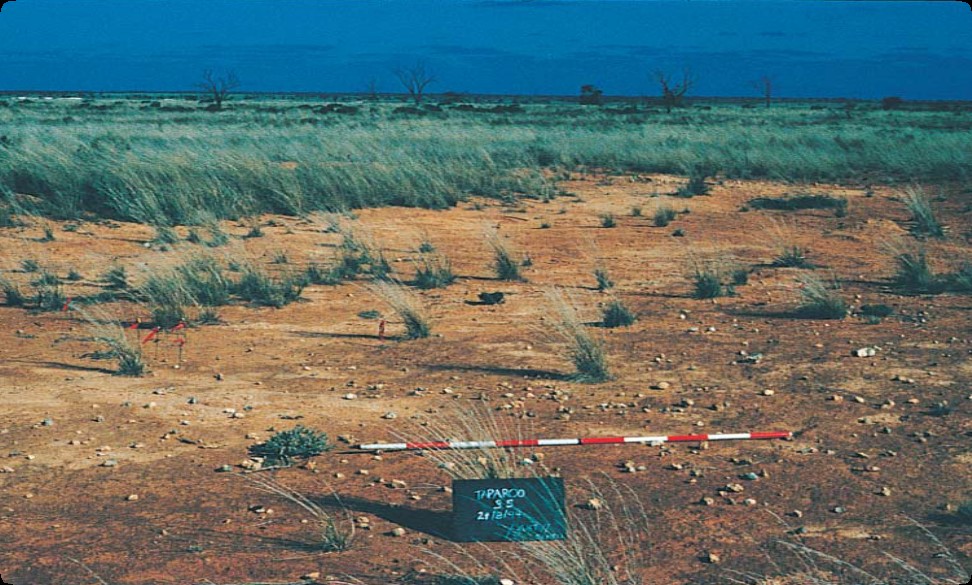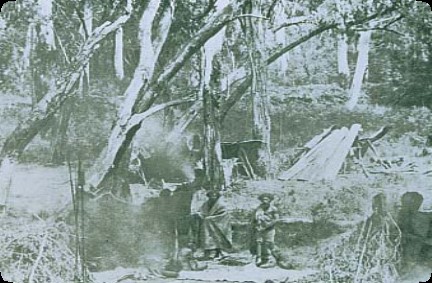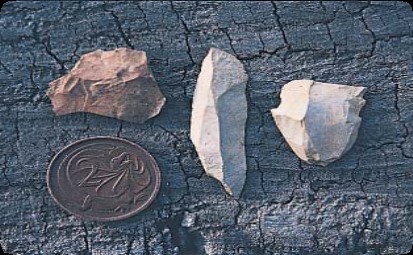Characteristics
- the size of scatters may vary from one square metre to one hectare
- scatters may contain a few artefacts or many thousands
- generally consist of chipped stone artefacts, but sometimes contain animal bone, shell, charcoal, hearth stones, clay balls and ochre
- surface scatters are most visible where erosion, roadwork, ploughing or earthworks have disturbed the ground
- can be exposed as a concentration of material on the ground, or as a thin layer (or layers) of material in the side of a bank or cutting
What are Aboriginal surface scatters?
Surface artefact scatters are the material remains of past Aboriginal people’s activities. Scatter sites usually contain stone artefacts, but other material such as charcoal, animal bone, shell and ochre may also be present. No two surface scatters are exactly the same.
Where are they found?
Surface scatters can be found wherever Aboriginal occupation has occurred in the past. Aboriginal campsites were most frequently located near a reliable source of freshwater, so surface scatters are often found near rivers or streams where erosion or disturbance has exposed an older land surface.
What produced surface scatters?
Surface scatters are the remains of past Aboriginal campsites and other activities. Aboriginal people produced and left the scatter material in the course of their daily life.
Activities that produced surface scatters include:
- manufacture of stone implements for a range of everyday tasks
- production and maintenance of weapons, tools and other items made of wood and bone
- construction of shelters and huts
- preparation and consumption of meals
- preparation of clothes and blankets from animal skins
- social and spiritual activities
Away from the camp, activities that produced surface scatters include:
- wood chopping and the removal of bark from trees
- preparation of large items such as canoes
- hunting and game processing
- gathering and processing fruit and vegetables
Scatters may be the remains from a number of activities in a camp, or from just one activity away from the main camp site.
Large surface scatters with many types of artefacts indicate favoured camping areas. These were often resource-rich areas such as swamps, lakes or riverine environments.
Aboriginal people returned to these locations repeatedly, stayed for longer periods, and undertook a wider range of activities. A large scatter may have many thousands of artefacts and cover more than a hectare.
The repeated use of an area may have left a dense deposit that is many layers thick, or a huge scatter consisting of artefacts from many overlapping occupations.
Smaller places generally resulted from single, short occupations such as overnight camps and dinner camps.
Some consist of debris at an activity area away from the main camp. Small scatters may cover only a few square metres, consist of only one layer and comprise only a few artefacts. They can be found anywhere, whereas larger scatters are rarer in resource-poor areas such as coastal plains, highlands and deserts.
What other factors produce surface scatters?
Scatters of naturally occurring gravel, particularly quartz, may be mistaken for Aboriginal surface scatters.
Gravel usually has rounded edges and originates in the immediate area. Imported gravel, particularly from roadwork or building construction, can also be mistaken for surface scatters. Imported gravel has sharp edges and a narrow size range, and it is usually found around earthworks.
Why are Aboriginal surface scatters important?
Surface scatters of artefacts are one of the most common types of Aboriginal places. They provide important information about past Aboriginal people’s settlement patterns and lifestyles.
Some organic materials (such as charcoal, bone and shell) found in scatters can be dated by radiocarbon dating. These dates tell us when people were living in a particular area.
Artefacts in the surface scatters can show how Aboriginal culture changed over time. The presence of stone from other areas can indicate trade, exchange and contact between different groups that lived many kilometres apart.
Surface scatters are an important link for Aboriginal people today with their culture and past.
Are Aboriginal surface scatters under threat?
Aboriginal surface scatters can be disturbed or destroyed by people or natural processes such as wind and water. Weathering and erosion can damage or disperse artefacts, as can trampling by hard-hoofed animals and rabbit burrowing.
Human activities such as mining, road building, damming, clearing and construction can disturb and destroy artefact sites.
First Peoples - State Relations records the location, dimensions and condition of Aboriginal scatters. The aim is to have a permanent photographic and written record of this important part of the heritage of all Australians.
Management works around Aboriginal surface scatters, such as the eradication of rabbits and erosion control, help preserve the places for future generations.
Are Aboriginal surface scatters protected?
All Aboriginal cultural places in Victoria are protected by law. Aboriginal artefacts are also protected.
It is illegal to disturb or destroy an Aboriginal place. Artefacts should not be removed from site.
What to do if you find an Aboriginal surface scatter?
Do not disturb the place or remove any material. Check whether the place has the characteristics of an Aboriginal surface scatter. If it does, record its location and write a brief description of its condition. Note whether it is under threat of disturbance.
Please help to preserve Aboriginal cultural places by reporting their presence to First Peoples - State Relations.
Updated




